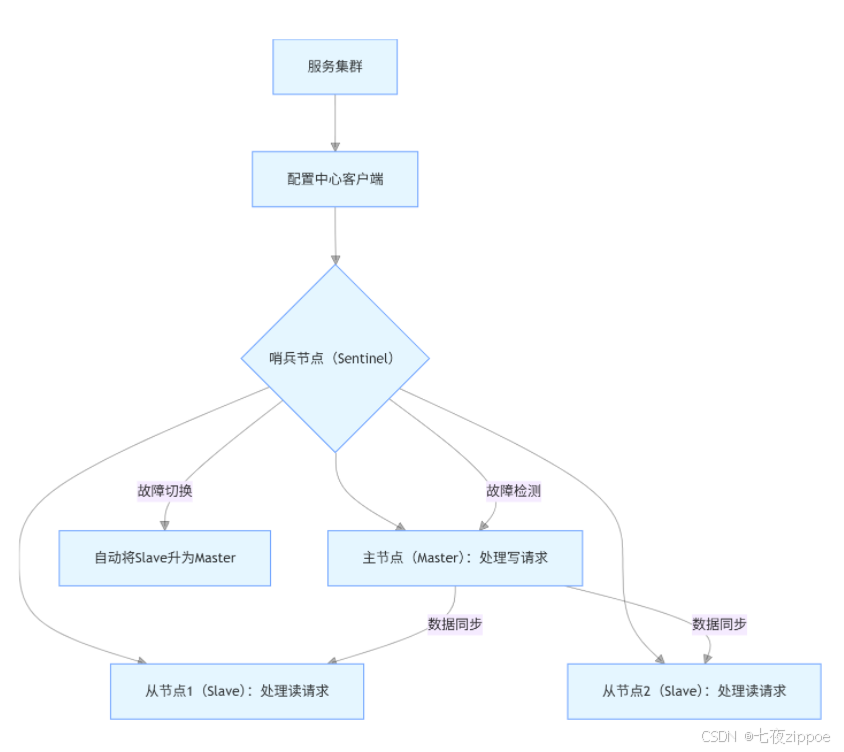开篇:一个因配置中心不可用导致的生产故障(📌 真实案例)
2023 年电商大促期间,某平台出现5 分钟服务集群不可用,根因是:
-
配置中心采用 "单节点 + 本地缓存" 架构,节点宕机后缓存过期;
-
服务重启时无法拉取配置,导致库存、支付服务集体熔断;
-
无降级方案,运维手动恢复耗时超 10 分钟。
这个案例暴露了配置中心高可用的核心诉求:"不宕机、能同步、可容错"。下文将围绕这三个诉求,拆解实战方案。
一、先搞懂:配置中心高可用的 3 个核心痛点(⚠️ 问题拆解)
在设计方案前,需先明确实战中最常踩的坑,避免 "为设计而设计":
| 痛点类型 | 实战表现 | 影响范围 |
|---|---|---|
| 部署层单点故障 | 配置中心节点宕机,服务无法拉取 / 更新配置 | 全链路服务(如订单、物流) |
| 数据同步不一致 | 多节点配置同步延迟,部分服务用旧配置 | 依赖该配置的服务集群 |
| 容错能力缺失 | 配置中心故障时,服务无兜底策略直接熔断 | 单个服务或关联链路 |
下文方案将针对这 3 个痛点,从 "基础设施层→核心功能层→容错防护层" 分层落地。
二、基础设施层:用 "多活部署" 解决单点故障(🔧 落地方案)
配置中心高可用的基石是 **"无单点部署"**,实战中主流方案是 "跨节点集群 + 跨机房容灾",以下为两种落地模式的对比与代码实现。
1. 模式 1:单机房内的 "主从 + 哨兵" 集群(适合中小规模微服务)
1.1 架构图(📊 可视化)

1.2 核心配置代码(💻 可复用)
以主流配置中心Nacos 为例,集群部署的application.properties关键配置(单机房 3 节点):
java
\# 节点1(Master候选)配置
server.port=8848
spring.datasource.platform=mysql
db.num=1
db.url.0=jdbc:mysql://192.168.1.100:3306/nacos?characterEncoding=utf8\&connectTimeout=1000\&socketTimeout=3000\&autoReconnect=true
db.user=root
db.password=123456
\# 集群节点列表(3节点IP:端口)
nacos.inetutils.ip-address=192.168.1.101
cluster.conf.content=192.168.1.101:8848,192.168.1.102:8848,192.168.1.103:8848
\# 开启哨兵模式(自动故障切换)
nacos.core.sentinel.enabled=true
\# 主节点选举阈值(2票即可当选)
nacos.core.sentinel.quorum=21.3 实战注意点(📌 踩坑总结)
-
节点数量需为奇数(3/5 节点),避免脑裂(如 2 节点均认为自己是 Master);
-
数据库需用主从同步(如 MySQL MGR),避免配置数据存储单点;
-
哨兵节点需独立部署(至少 2 个),避免与配置节点共节点导致 "一起宕机"。
2. 模式 2:跨机房 "多活集群"(适合大规模 / 高可用要求高的场景)
2.1 核心同步代码(💻 可复用)
以Apollo配置中心为例,跨机房数据同步的核心代码(基于 HTTP 异步同步):
java
/\*\*
\* 跨机房配置同步服务(Apollo自定义扩展)
\*/
@Service
public class CrossRoomConfigSyncService {
// 上海机房配置中心地址
private static final String SHANGHAI\_ROOM\_URL = "http://10.0.2.100:8080/apollo/admin/v1/configs/sync";
// 异步线程池(避免同步阻塞主流程)
@Resource
private ExecutorService crossRoomSyncExecutor;
/\*\*
\* 配置变更后,异步同步到上海机房
\* @param configChange 配置变更对象(含namespace、key、value)
\*/
public void syncToShanghaiRoom(ConfigChange configChange) {
crossRoomSyncExecutor.submit(() -> {
try {
// 1. 封装同步请求(含签名,防止篡改)
HttpPost post = new HttpPost(SHANGHAI\_ROOM\_URL);
String syncBody = JSON.toJSONString(buildSyncRequest(configChange));
StringEntity entity = new StringEntity(syncBody, ContentType.APPLICATION\_JSON);
post.setEntity(entity);
// 2. 添加身份认证(Apollo的token)
post.addHeader("Authorization", "Bearer " + getApolloToken());
// 3. 发送同步请求(超时时间3秒,避免阻塞)
CloseableHttpClient client = HttpClients.createDefault();
CloseableHttpResponse response = client.execute(post);
int statusCode = response.getStatusLine().getStatusCode();
// 4. 同步失败重试(最多3次,间隔1秒)
if (statusCode != 200) {
retrySync(configChange, 3);
}
} catch (Exception e) {
log.error("跨机房同步配置失败,configKey:{}", configChange.getKey(), e);
// 同步失败告警(接入企业微信/钉钉)
alertService.sendAlert("跨机房配置同步失败", e.getMessage());
}
});
}
// 构建同步请求(含配置版本号,避免重复同步)
private SyncRequest buildSyncRequest(ConfigChange change) {
SyncRequest request = new SyncRequest();
request.setAppId(change.getAppId());
request.setNamespace(change.getNamespace());
request.setConfigKey(change.getKey());
request.setConfigValue(change.getNewValue());
request.setVersion(change.getVersion()); // 版本号用于去重
return request;
}
// 重试逻辑(指数退避)
private void retrySync(ConfigChange change, int retryCount) throws InterruptedException {
if (retryCount <= 0) return;
Thread.sleep(1000 \* (4 - retryCount)); // 1s→2s→3s
syncToShanghaiRoom(change);
}
}2.3 实战案例(📌 某金融项目落地)
某银行跨北京、上海机房部署 Apollo,解决了两个核心问题:
-
问题 1:跨机房同步延迟(原延迟 500ms+)→ 方案:在同步代码中增加 "版本号校验",避免重复同步,延迟降至 100ms 内;
-
问题 2:机房故障切流不及时→ 方案:接入阿里云 ARMS,当机房 A 节点存活数 < 2 时,自动将服务流量切到机房 B,切流耗时 < 30 秒。
三、核心功能层:用 "可靠同步 + 高效读取" 解决数据一致性问题(🔧 落地方案)
配置中心的核心功能是 "配置同步" 和 "配置读取",实战中需解决 "同步丢数据""读取性能低" 两个问题。
1. 配置同步:推拉结合,避免丢数据(📊 时序图 + 代码)
1.1 核心代码:长轮询实现(💻 基于 Spring Cloud Config)
java
/\*\*
\* 配置客户端长轮询组件(解决"推模式不可靠"问题)
\*/
@Component
public class ConfigLongPollingComponent {
// 配置中心服务端地址
private static final String CONFIG\_SERVER\_URL = "http://config-server:8888/configs";
// 长轮询超时时间(30秒,避免频繁请求)
private static final int POLL\_TIMEOUT = 30 \* 1000;
// 本地记录的配置版本(用于对比是否变更)
private String localConfigVersion = "1.0.0";
/\*\*
\* 启动长轮询(服务启动时执行)
\*/
@PostConstruct
public void startLongPolling() {
ScheduledExecutorService executor = Executors.newSingleThreadScheduledExecutor();
// 初始延迟0秒,每30秒执行一次(与超时时间一致)
executor.scheduleAtFixedRate(this::pollConfigChange, 0, POLL\_TIMEOUT, TimeUnit.MILLISECONDS);
}
/\*\*
\* 长轮询核心逻辑:请求服务端,若配置变更则拉取
\*/
private void pollConfigChange() {
try {
// 1. 构建长轮询请求(携带本地版本号)
HttpGet get = new HttpGet(CONFIG\_SERVER\_URL + "?version=" + localConfigVersion + "\&timeout=" + POLL\_TIMEOUT);
CloseableHttpClient client = HttpClients.createDefault();
CloseableHttpResponse response = client.execute(get);
// 2. 处理响应(分两种情况)
if (response.getStatusLine().getStatusCode() == 200) {
// 情况1:配置已变更(服务端立即返回新配置)
String responseBody = EntityUtils.toString(response.getEntity());
ConfigResponse configResponse = JSON.parseObject(responseBody, ConfigResponse.class);
// 更新本地配置+版本号
updateLocalConfig(configResponse);
log.info("配置已更新,新版本:{}", configResponse.getVersion());
} else if (response.getStatusLine().getStatusCode() == 304) {
// 情况2:配置未变更(服务端超时后返回304)
log.debug("配置未变更,本地版本:{}", localConfigVersion);
}
} catch (Exception e) {
log.error("长轮询获取配置失败", e);
// 失败时降级:5秒后重试(避免频繁报错)
try {
Thread.sleep(5000);
} catch (InterruptedException ie) {
Thread.currentThread().interrupt();
}
}
}
/\*\*
\* 更新本地配置(应用到Spring环境)
\*/
private void updateLocalConfig(ConfigResponse response) {
// 1. 更新本地版本号
this.localConfigVersion = response.getVersion();
// 2. 更新Spring环境中的配置(如支付超时时间)
ConfigurableApplicationContext context = SpringContextHolder.getApplicationContext();
ConfigurableEnvironment environment = context.getEnvironment();
MutablePropertySources propertySources = environment.getPropertySources();
// 3. 覆盖原有配置(优先级:配置中心 > 本地配置)
MapPropertySource configServerSource = new MapPropertySource("configServer", response.getConfigMap());
if (propertySources.contains("configServer")) {
propertySources.replace("configServer", configServerSource);
} else {
propertySources.addFirst(configServerSource);
}
// 4. 触发配置变更事件(如@RefreshScope注解的Bean刷新)
context.publishEvent(new EnvironmentChangeEvent(response.getConfigMap().keySet()));
}
}1.2 实战坑点:同步丢数据的解决(📌 某电商项目案例)
问题:大促期间,同时修改 10 个配置项,部分服务只收到 8 个变更通知。
根因:推模式的 HTTP 请求被网络丢包,且无重试机制。
解决方案:
-
在服务端增加 "同步日志",每推一次记录一条日志(含配置项、接收服务 IP);
-
客户端收到通知后,向服务端发送 "确认回执",未收到回执则服务端重试(最多 3 次);
-
每日凌晨执行 "全量配置校验",对比客户端与服务端配置版本,不一致则补拉。
2. 配置读取:多级缓存,提升性能(📊 缓存架构 + 代码)
2.1核心代码:多级缓存实现(💻 基于 Caffeine+Redis)
java
/\*\*
\* 配置多级缓存组件(内存缓存Caffeine + 分布式缓存Redis)
\*/
@Component
public class ConfigMultiLevelCache {
// 1. 本地内存缓存(Caffeine,过期时间5分钟,防止内存溢出)
private final LoadingCache\<String, String> localCache = Caffeine.newBuilder()
.expireAfterWrite(5, TimeUnit.MINUTES)
.maximumSize(1000) // 最多缓存1000个配置项
.build(this::loadFromRedis); // 缓存缺失时从Redis加载
// 2. 分布式缓存(Redis)
@Resource
private StringRedisTemplate redisTemplate;
// Redis缓存过期时间(1小时)
private static final Duration REDIS\_EXPIRE = Duration.ofHours(1);
// Redis key前缀(区分不同应用的配置)
private static final String REDIS\_KEY\_PREFIX = "config:cache:";
/\*\*
\* 获取配置(优先走多级缓存)
\* @param appId 应用ID
\* @param namespace 配置命名空间(如payment、order)
\* @param configKey 配置键
\* @return 配置值
\*/
public String getConfig(String appId, String namespace, String configKey) {
// 构建唯一缓存键(避免不同应用/命名空间冲突)
String cacheKey = buildCacheKey(appId, namespace, configKey);
try {
// 1. 先查本地内存缓存
return localCache.get(cacheKey);
} catch (Exception e) {
log.error("获取配置缓存失败,cacheKey:{}", cacheKey, e);
// 缓存失败降级:直接请求配置中心服务端(兜底)
return loadFromConfigServer(appId, namespace, configKey);
}
}
/\*\*
\* 缓存缺失时,从Redis加载
\*/
private String loadFromRedis(String cacheKey) {
String value = redisTemplate.opsForValue().get(cacheKey);
if (value == null) {
// Redis也没有,从配置中心服务端加载,并更新Redis
String\[] keyParts = cacheKey.split(":");
String appId = keyParts\[2];
String namespace = keyParts\[3];
String configKey = keyParts\[4];
value = loadFromConfigServer(appId, namespace, configKey);
// 更新Redis缓存(带过期时间)
redisTemplate.opsForValue().set(cacheKey, value, REDIS\_EXPIRE);
}
return value;
}
/\*\*
\* 从配置中心服务端加载配置(兜底方案)
\*/
private String loadFromConfigServer(String appId, String namespace, String configKey) {
// 调用配置中心API(如Nacos的/configs接口)
String configServerUrl = String.format("http://nacos-server:8848/nacos/v1/cs/configs?dataId=%s\&group=%s\&appId=%s",
configKey, namespace, appId);
try {
return HttpUtil.get(configServerUrl); // 用hutool的HttpUtil简化请求
} catch (Exception e) {
log.error("从配置中心加载配置失败,appId:{}, namespace:{}, key:{}", appId, namespace, configKey, e);
// 终极兜底:返回本地默认配置(避免服务不可用)
return getDefaultConfig(namespace, configKey);
}
}
/\*\*
\* 构建唯一缓存键(格式:config:cache:appId:namespace:configKey)
\*/
private String buildCacheKey(String appId, String namespace, String configKey) {
return String.format("%s%s:%s:%s", REDIS\_KEY\_PREFIX, appId, namespace, configKey);
}
/\*\*
\* 终极兜底:返回本地默认配置(如支付超时默认30秒)
\*/
private String getDefaultConfig(String namespace, String configKey) {
Map\<String, Map\<String, String>> defaultConfigs = new HashMap<>();
// 初始化默认配置(可放在本地配置文件中)
defaultConfigs.put("payment", new HashMap\<String, String>() {{
put("payment.timeout", "30000"); // 支付超时默认30秒
put("payment.maxAmount", "100000"); // 单笔支付最大10万
}});
defaultConfigs.put("order", new HashMap\<String, String>() {{
put("order.expireTime", "1800000"); // 订单过期默认30分钟
}});
// 返回对应默认值(无默认值则返回空字符串)
return defaultConfigs.getOrDefault(namespace, new HashMap<>()).getOrDefault(configKey, "");
}
}2.2 性能对比(📊 实战数据)
某项目接入多级缓存后,配置读取性能提升显著:
| 读取场景 | 无缓存(直接查 DB) | 仅 Redis 缓存 | 多级缓存(Caffeine+Redis) |
|---|---|---|---|
| 平均耗时 | 50~80ms | 8~15ms | 0.5~2ms |
| 每秒并发量(TPS) | 1000~2000 | 10000~15000 | 50000~80000 |
| 配置中心负载 | 高(DB 压力大) | 中(Redis 压力) | 低(仅缓存更新时请求) |